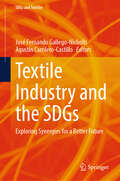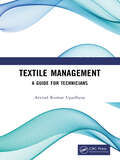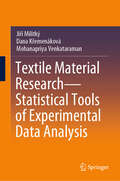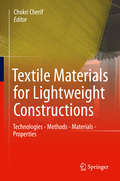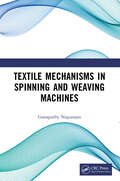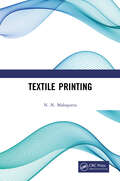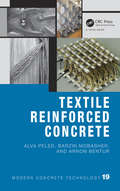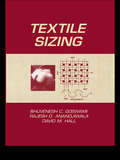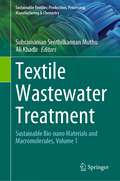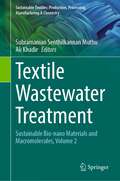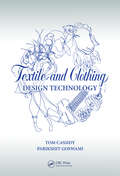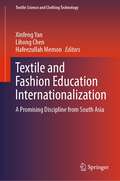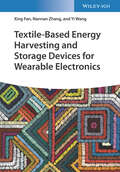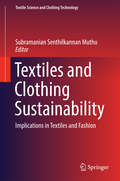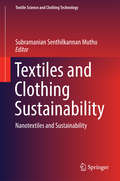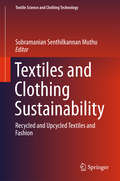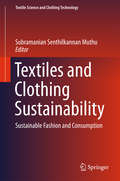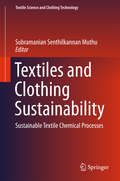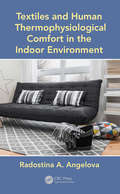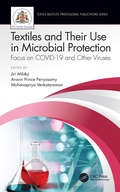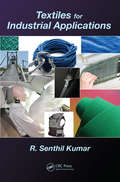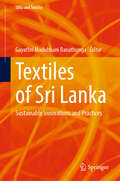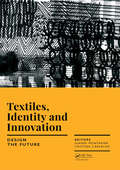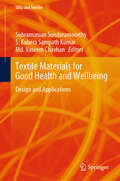- Table View
- List View
Textile Industry and the SDGs: Exploring Synergies for a Better Future (SDGs and Textiles)
by José Fernando Gallego-Nicholls Agustín Carrilero-CastilloThis book offers an exploration of the textile industry and their relationship to the Sustainable Development Goals (SDGs), catering specifically to academic researchers and providing a roadmap for aligning aligning textile research with the SDGs. It covers a wide range of topics, starting with an overview of the SDGs and their relevance to the textile industry. It examines the environmental footprint of textiles, including issues related to raw material sourcing, manufacturing processes, and waste management. Additionally, it explores the social and economic aspects of textiles, such as labor conditions, fair trade, and responsible consumption. One of the main focuses of this book is the role of innovation and technology in advancing sustainable textiles. It discusses emerging materials and technologies that promote circularity, reduce environmental harm, and enhance social well-being. Furthermore, it explores the potential of digitalization, artificial intelligence, and data analytics in optimizing textile production, distribution, and consumption patterns. This book also addresses the challenges and opportunities associated with sustainable textile supply chains. It analyzes the complexities of global value chains, the need for transparency and traceability, and the importance of collaboration among stakeholders. Furthermore, it highlights strategies for promoting sustainable fashion, encouraging responsible consumption, and fostering circular business models. By delving into these topics, this book aims to solve several key problems faced by academic researchers in the field of textiles and sustainability. It provides a holistic understanding of the SDGs and their integration into textile research, helping researchers align their work with broader sustainability objectives. It offers insights into the latest innovations and technologies, enabling researchers to explore cutting-edge solutions for sustainable textiles. Additionally, it presents case studies and best practices from industry leaders, inspiring researchers to undertake impactful research and contribute to positive change. This book is intended for academic researchers, as well as practitioners, specializing in textiles, sustainability, and related fields. It serves as a valuable resource for professors, postgraduate students, and professionals seeking to deepen their knowledge of the interplay between textiles and the SDGs. It encourages critical thinking, fosters interdisciplinary collaboration, and equips researchers with the tools and insights necessary to drive sustainable transformations within the textile industry and beyond.
Textile Management: A Guide for Technicians
by Arvind Kumar UpadhyayThis book covers the core principles of managing textiles, covering everything from sourcing and production to distribution and sustainability. The objective of this book is to provide relevant information about critical business aspects of the textile industry and its ancillary tools. It covers important concepts of business in a brief and simplified, yet practical way through examples in the form of reports, formats, figures related to respective subjects. Print edition not for sale in South Asia (Bangladesh, Bhutan, India, Nepal, Pakistan and Sri Lanka)
Textile Material Research—Statistical Tools of Experimental Data Analysis
by Mohanapriya Venkataraman Jiří Militký Dana KřemenákováThis book presents the effective combination of mathematical statistics, general metrology, and textile metrology to allow data analysis with regard to the evaluation of parameters of fibrous structures. Specialists working in material sciences, where fibrous structures are used, comprehensively understand the specifics of the fabric evaluation and manage in the context of rational use of selected mathematical and statistical methods. In this book, selected methods that are advantageous for data analysis, regardless of whether they are elementary or advanced are presented. The so-called computer-intensive methods are used in many situations when classical statistics is unable to offer a solution, or the solution is too complicated.
Textile Materials for Lightweight Constructions
by Chokri CherifIn this book, experts on textile technologies convey both general and specific information on various aspects of textile engineering, ready-made technologies, and textile chemistry. They describe the entire process chain from fiber materials to various yarn constructions, 2D and 3D textile constructions, preforms, and interface layer design. In addition, the authors introduce testing methods, shaping and simulation techniques for the characterization of and structural mechanics calculations on anisotropic, pliable high-performance textiles, including specific examples from the fields of fiber plastic composites, textile concrete and textile membranes. Readers will also be familiarized with the potential offered by increasingly employed textile structures, for instance in the fields of composite technology, construction technology, security technology and membrane technology.
Textile Mechanisms in Spinning and Weaving Machines
by Ganapathy NagarajanThis book discusses the mechanics in textile machinery in spinning, weaving and knitting processes. It is a useful resource for developing an analytical thinking about the machineries by providing information about the various mechanisms involved. The subject matter of this book includes – Gear trains Equations of movement Resolution of forces Principle of moments Stress, strain and elasticity Print edition not for sale in South Asia (India, Sri Lanka, Nepal, Bangladesh, Pakistan and Bhutan)
Textile Printing
by N. N. MahapatraTextile printing is the process of applying colour to fabric in definite patterns or designs. This book covers different methods of textile printing like hand block printing, perrotine printing, engraved copperplate printing, roller-cylinder-machine printing, stencil printing, screen printing, digital textile printing, flexo-textile printing, and discharge printing. Print edition not for sale in South Asia (Bangladesh, Bhutan, India, Nepal, Pakistan and Sri Lanka)
Textile Reinforced Concrete (Modern Concrete Technology #19)
by Alva Peled Arnon Bentur Barzin MobasherTextile reinforced concrete (TRC) has emerged in recent years as an attractive new high performance cement-based composite. Textiles can significantly improve the mechanical behavior of cement matrices under static and dynamic conditions, and give superior tensile strength, toughness, ductility, energy absorption and protection against environmental degrading influences. Flexibility with fabric production methods enables the control of fabric and yarn geometry. This, along with the ability to incorporate into the fabric a range of yarns of different types and performances, as well as cement matrix modifications, enables design of the composite to a wide range of needs. The book is intended to provide a comprehensive treatment of TRC, covering the basic fundamentals of the composite material itself and the principles governing its performance on a macro-scale as a component in a structure. It provides in-depth treatment of the fabric, methods for production of the composite, the micro-mechanics with special attention to the role of bonding and microstructure, behavior under static and dynamic loading, sustainability, design, and the applications of TRC composites.
Textile Sizing
by David Hall Bhuvenesh C. Goswami Rajesh D. AnandjiwalaHelping you keep pace with rapid developments in the field, Textile Sizing documents the rapidly changing scenario in textile processing and research in sizing. The authors analyze new fibers, spinning methods, and weaving techniques affecting textile production and studies the impact of fiber properties, yarn quality, sizing processes and material
Textile Wastewater Treatment: Sustainable Bio-nano Materials and Macromolecules, Volume 1 (Sustainable Textiles: Production, Processing, Manufacturing & Chemistry)
by Subramanian Senthilkannan Muthu Ali KhadirIn this first volume, various materials such as chitosan, lignin-based biomaterials, cellulosic based bio materials, carbon materials, Polysaccharide-composites materials, Aromatic-Based Synthetic Macromolecules, Agricultural wastes, etc for treating textile waste water are highlighted. One of the major pollutants in the textile and fashion industry is (textile) waste water. Textile wastewater can lead to serious environmental issues if discharged without proper and sufficient treatment. The materials employed along with the technologies available to trate waste water are the key. There are a lot of advancements in terms materials, technologies employed for textile waste water treatment. Sustainable bio-nano materials and macro molecules play a major role in the efficient treatment of textile waster.
Textile Wastewater Treatment: Sustainable Bio-nano Materials and Macromolecules, Volume 2 (Sustainable Textiles: Production, Processing, Manufacturing & Chemistry)
by Subramanian Senthilkannan Muthu Ali KhadirIn this second volume, various materials such as Magnetic-based biocomposites, wheat bran/straw-based biomaterials, peel-based biomaterials, luffa Based Biomaterials, composite polymeric membranes, rice husk, hydroxyapatite etc for treating textile waste water are highlighted. One of the major pollutants in the textiles and fashion sector is textile waste water. Textile wastewater can lead to serious environmental issues if discharged without proper and sufficient treatment. The materials employed along with the technologies available to trate the waste water are the key. There are a lot of advancements in terms materials, technologies employed for textile waste water treatment. Sustainable bio-nano materials and macro molecules play a major role in the efficient textile waste treatment.
Textile and Clothing Design Technology
by Tom Cassidy and Parikshit GoswamiIn the textile industry, there is a pressing need for people who can facilitate the translation of creative solutions from designers into manufacturing language and data. The design technologist has to understand the elements and principles employed by designers and how these change for various textile media. One must also have a good understanding of the processes, materials and products for which the textile designer is required to produce creative solutions. This book will be for designers wishing to improve their technological knowledge, technologists wishing to understand the design process, and anyone else who seeks to work at this design-technology interface. Key Features: • Provides a comprehensive information about textile production, apparel production and the design aspects of both textile and apparel production. • Fills the traditional gap between design and manufacture changing with advanced technologies. • Includes brief summary of spinning, weaving, chemical processing and garmenting. • Facilitates translation of creative solutions from designers into manufacturing language and data. • Covers set of workshop activities.
Textile and Fashion Education Internationalization: A Promising Discipline from Southeast Asia (Textile Science and Clothing Technology)
by Hafeezullah Memon Xinfeng Yan Lihong ChenThis book explains the past, present, and future of textile, fashion, apparel, and related majors of South Asian countries. The chapters express the hidden potential of textiles in South Asia. In this book, experts in textile engineering of each country describe the potential and prospects of textile education and how it can lead to internationalization. The book contains updated new illustrations, images, data, graphs, and tables. It also discusses the textile university alliance and the potential for international education related to textiles in the developing region.
Textile-Based Energy Harvesting and Storage Devices for Wearable Electronics
by Yi Wang Xing Fan Nannan ZhangDiscover state-of-the-art developments in textile-based wearable and stretchable electronics from leaders in the field In Textile-Based Energy Harvesting and Storage Devices for Wearable Electronics, renowned researchers Professor Xing Fan and his co-authors deliver an insightful and rigorous exploration of textile-based energy harvesting and storage systems. The book covers the principles of smart fibers and fabrics, as well as their fabrication methods. It introduces, in detail, several fiber- and fabric-based energy harvesting and storage devices, including photovoltaics, piezoelectrics, triboelectrics, supercapacitors, batteries, and sensing and self-powered electric fabrics. The authors also discuss expanded functions of smart fabrics, like stretchability, hydrophobicity, air permeability and color-changeability. The book includes sections on emerging electronic fibers and textiles, including stress-sensing, strain-sensing, and chemical-sensing textiles, as well as emerging self-powered electronic textiles. Textile-Based Energy Harvesting and Storage Devices for Wearable Electronics concludes with an in-depth treatment of upcoming challenges, opportunities, and commercialization requirements for electronic textiles, providing valuable insight into a highly lucrative new commercial sector. The book also offers: A thorough introduction to the evolution from classical functional fibers to intelligent fibers and textiles An exploration of typical film deposition technologies, like dry-process film deposition and wet-process technologies for roll-to-roll device fabrication Practical discussions of the fabrication process of intelligent fibers and textiles, including the synthesis of classical functional fibers and nano/micro assembly on fiber materials In-depth examinations of energy harvesting and energy storage fibers, including photovoltaic, piezoelectric, and supercapacitor fibers Perfect for materials scientists, engineering scientists, and sensor developers, Textile-Based Energy Harvesting and Storage Devices for Wearable Electronics is also an indispensable resource for electrical engineers and professionals in the sensor industry seeking a one-stop reference for fiber- and fabric-based energy harvesting and storage systems for wearable and stretchable power sources.
Textiles and Clothing Sustainability: Implications in Textiles and Fashion
by Subramanian Senthilkannan MuthuThis book comprehensively covers the topic of sustainability in the clothing and fashion sector. Sustainability is applied under different industrial sectors and there has to be a distinction in every industrial sector when it comes to sustainability in its application. Though the definition is common for sustainability, sustainability in the clothing sector has its unique objectives, principles, and limitations, which this book highlights.
Textiles and Clothing Sustainability: Nanotextiles and Sustainability
by Subramanian Senthilkannan MuthuThis book highlights the sustainability aspects of textiles and clothing sector in light of nanomaterials and technologies. The invasion of nano in every industrial sector has been important and has made remarkable changes as well as posed new challenges, including the textiles and clothing sector. There is quite a great deal of research happening in terms of nano materials for textiles across the globe, some of which are covered in this book.
Textiles and Clothing Sustainability: Recycled and Upcycled Textiles and Fashion
by Subramanian Senthilkannan MuthuThis book discusses in detail the concepts of recycling and upcycling and their implications for the textiles and fashion sector. In addition to the theoretical concepts, the book also presents various options for recycling and upcycling in textiles and fashion. Although recycling is a much-developed and widely used concept, upcycling is also gaining popularity in the sector.
Textiles and Clothing Sustainability: Sustainable Fashion and Consumption
by Subramanian Senthilkannan MuthuThis is the first book to introduce and explain the concept of sustainable consumption with reference to the clothing sector. It uses various case studies to detail sustainable consumption behavior in the industry. Consumption is a key issue and is a major driver when it comes to sustainability in any industry, including clothing sector. Several studies which have highlighted the need for sustainable consumption in the clothing sector are discussed in this book.
Textiles and Clothing Sustainability: Sustainable Textile Chemical Processes
by Subramanian Senthilkannan MuthuThis book highlights the challenges in sustainable wet processing of textiles, natural dyes, enzymatic textiles and sustainable textile finishes. Textile industry is known for its chemical processing issues and many NGO’s are behind the textile sector to streamline its chemical processing, which is the black face of clothing and fashion sector. Sustainable textile chemical processes are crucial for attaining sustainability in the clothing sector. Seven comprehensive chapters are aimed to highlight these issues in the book.
Textiles and Human Thermophysiological Comfort in the Indoor Environment
by Radostina A. AngelovaTextiles and Human Thermophysiological Comfort in the Indoor Environment delivers a methodical assessment of textile structures for various applications in the indoor environment with respect to the thermophysiological comfort of the inhabitants. The book begins by offering an overview of the role of indoor textiles and clothing as a barrier betwee
Textiles and Their Use in Microbial Protection: Focus on COVID-19 and Other Viruses (Textile Institute Professional Publications)
by Aravin Prince Periyasamy Mohanapriya Venkataraman Jiri MilitkýTextiles and Their Use in Microbial Protection: Focus on COVID-19 and Other Viruses provides readers with vital information about disinfection mechanisms used in textile applications in the fight against dangerous microbes and viruses. KEY FEATURES: Introduces the basics of textile materials used for medical applications Features key information on virology, characterization, indication, and passivation of COVID-19 Describes UV, photocatalysis, photooxidation, application of TiO2, copper-based viral inhibition, and activated carbon Discusses antiviral finishes for the protection against SARS-CoV-2, particle penetration in dense cotton fabrics under swollen state, and the impact of moisture on face masks and their designs Aimed at textile and materials engineers as well as readers in medical fields, this text offers a comprehensive view of fundamentals and solutions in the use of textiles for microbial protection.
Textiles for Industrial Applications
by R. Senthil KumarAn evolution is currently underway in the textile industry and Textile for Industrial Applications is the guidebook for its growth. This industry can be classified into three categories-clothing, home textile, and industrial textile. Industrial textiles, also known as technical textiles, are a part of the industry that is thriving and showing great
Textiles of Sri Lanka: Sustainable Innovations and Practices (SDGs and Textiles)
by Gayathri Madubhani RanathungaThis book highlights the role of sustainable development in ancient practices to modern innovations in the textiles of Sri Lanka. It reveals the textile of Sri Lanka from the historical age to current tech-fabrics. Supporting the sustainable development goals, this book covers the most sought-after concepts and practices in textile industry of Sri Lanka such as of maximum utilization, zero waste, eco-friendly production process, reuse, upcycling, recycling, and longevity. Various topics covered in this book are indigenous cultural textiles, women empowerment, agro-waste utilization, secondhand-fashion consumption, and many more. The book is a valuable reference for beginners, university students, researchers, and professionals interested in sustainable development in textiles and allied fields.
Textiles, Identity and Innovation: Proceedings of the 1st International Textile Design Conference (D_TEX 2017), November 2-4, 2017, Lisbon, Portugal
by Gianni Montagna; Cristina CarvalhoD_TEX presents itself as a starting point at a crossroads of ideas and debates around the complex universe of Textile Design in all its forms, manifestations and dimensions. The textile universe, allied to mankind since its beginnings, is increasingly far from being an area of exhausted possibilities, each moment proposing important innovations that need a presentation, discussion and maturation space that is comprehensive and above all inter- and transdisciplinary. Presently, the disciplinary areas where the textile area is present are increasing and important, such as fashion, home textiles, technical clothing and accessories, but also construction and health, among others, and can provide new possibilities and different disciplinary areas and allowing the production of new knowledge. D_TEX proposes to join the thinking of design, with technologies, tradition, techniques, and related areas, in a single space where ideas are combined with the technique and with the projectual and research capacity, thus providing for the creation of concepts, opinions, associations of ideas, links and connections that allow the conception of ideas, products and services. The interdisciplinary nature of design is a reality that fully reaches the textile material in its essence and its practical application, through the synergy and contamination by the different interventions that make up the multidisciplinary teams of research. The generic theme of D_TEX Textile Design Conference 2017, held at Lisbon School of Architecture of the University of Lisbon, Portugal on November 2-4, 2017, is Design the Future, starting from the crossroads of ideas and debates, a new starting point for the exploration of textile materials, their identities and innovations in all their dimensions.
Textile Materials for Good Health and Wellbeing: Design and Applications (SDGs and Textiles)
by Subramanian Sundaramoorthy S. Kubera Sampath Kumar Md. Vaseem ChavhanThis book explores the application of latest technologies such as nanotechnology, composite technology, biotechnology in textile materials for health-related applications. It further discusses different types of textiles and their application in the areas of health, safety and well-being. Various topics covered in this book are, medical textiles, filtration textiles, protective textiles, thermal protective wear, intelligent textiles and many more. The book also deals with air and water filtration textiles and textile-based personal protective equipments. This book will be of interest for students, researchers and professionals working in the area of textile engineering, materials, biomedical engineering, defense, healthcare and other allied fields.
Textual Intercourse
by Laura SabaForget instant messaging and e-mail?we are undergoing a text message revolution Text messaging is the newest and preferred wave of communication for the younger demographic and the number one application of cell phones. The market is ripe for this relationship guide for texters With this new trend come all kinds of questions and confusion concerning textual communication and protocol within relationships girls never would have imagined a generation ago. Tantalizing topics include: ? The dos and donOCOts of texting your significant other? Interpreting exactly what his text messages mean? Finding the right balance between texting and in-person communication? The ins and outs of building textual confidence? The art of textual flirtation? And so much more This revealing and useful book demonstrates exactly how those tiny text messages you send today can create big success for your love life tomorrow. "
